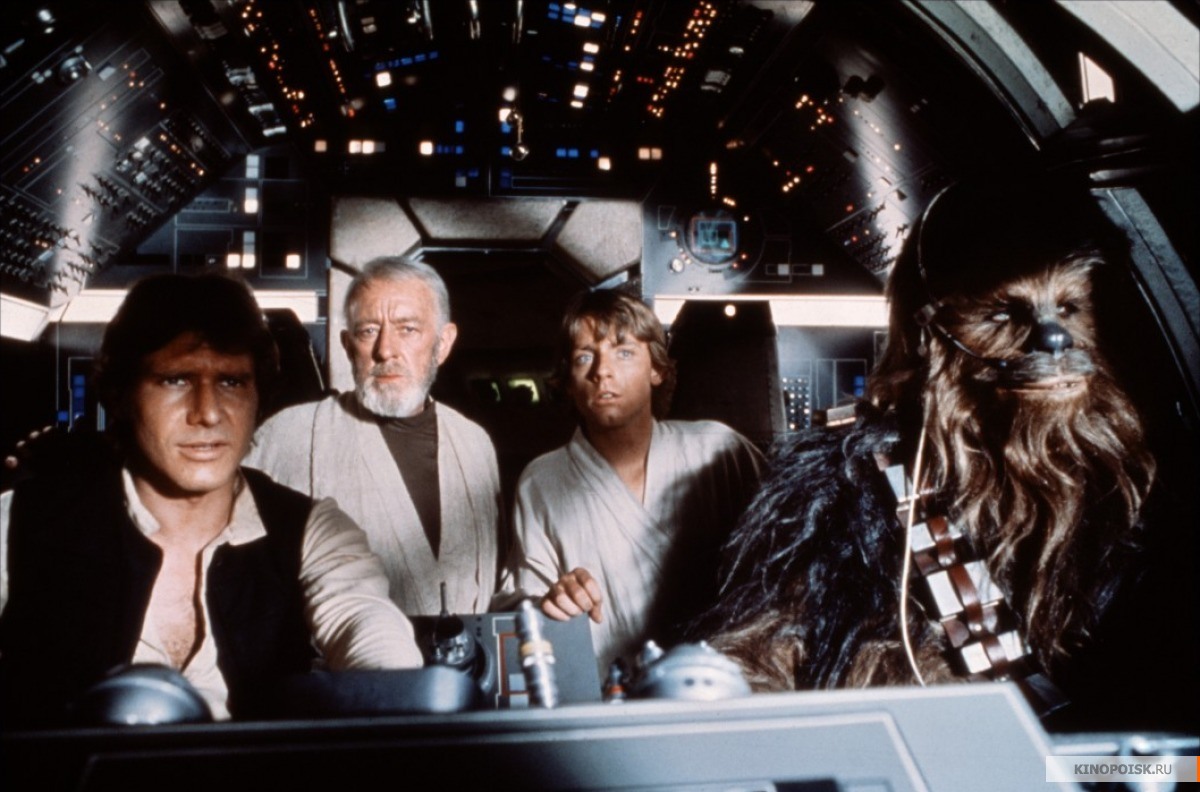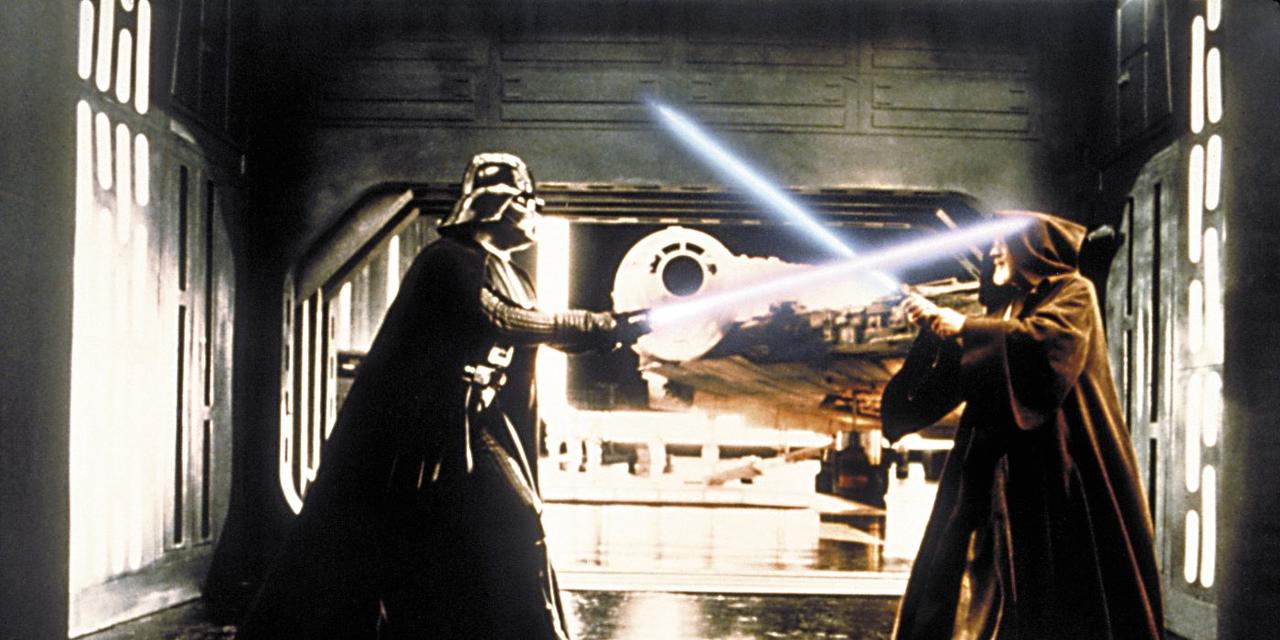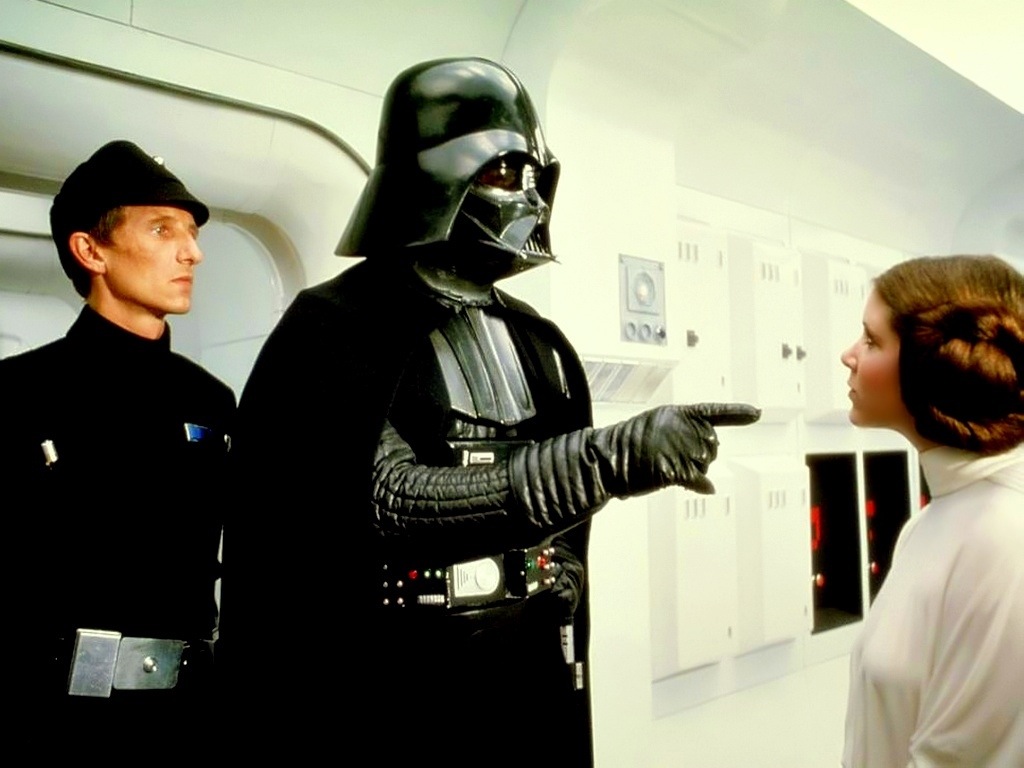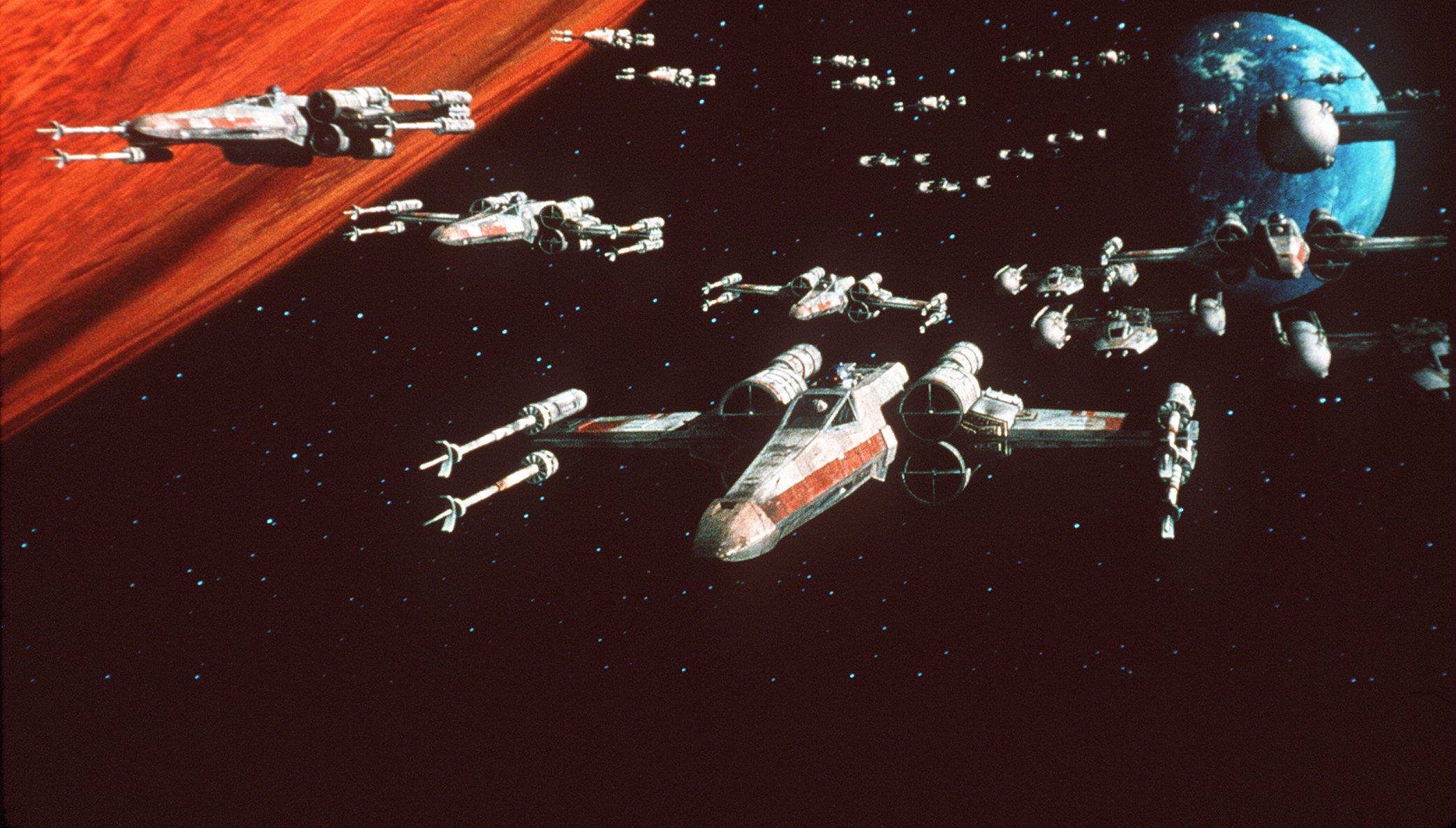There’s no denying that Star Wars and its myriad sequels and spin-offs are a bona fide cultural phenomenon. Nor can there be any denying it’s enduring popularity and the huge influence that the success of the first film in particular has had on the film industry as a whole and the science fiction genre in particular. What should be called into question – and what often isn’t – is whether or not that influence has been for the good.
To those of us not enthralled by the whole Star Wars phenomenon, it’s difficult to get past the many, many failings and shortcomings in Star Wars. The wellspring from which all these failings emerge is clearly Lucas’ dreadful script, a messy hodgepodge of genre clichés and tropes lifted from a dozen or more better sources (both in and out of genre, from film, mythology and print) and strung together in a feeble plot held together by coincidence and chance. Star Wars was aimed squarely at the child in its target audience but at times it actually seems like the script had been written by an adolescent, so full is it of lousy dialogue, ill-conceived ideas and poorly plotted twists.

The plot relies entirely on chance – our heroes always just happen to be in the right place at the right time, always turning up just where and when the plot needs them, always messing with highly trained Imperial Stormtroopers who suddenly lose the ability to shoot straight (don’t give me any nonsense about them being protected by The Force, it’s just sloppy writing), always meeting exactly the people and droids they need to meet to keep the clumsy storyline stumbling forwards. It’s not even internally consistent – surveying the damage caused by a patrol of Stormtroopers on the Jawa transporter on Tatooine, Obi-Wan notes: “These blast points – too accurate for Sand People. Only Imperial Stormtroopers are so precise.” And yet for the rest of the film, these same Stormtroopers would have trouble hitting a barn door at ten paces armed with a rocket launcher.
Star Wars fans – of which there are of course many hundreds of thousands – love the film for its simplicity, its lack of pretension and it’s straightforward, linear narrative. Fair enough. But those of us immune to its charms find the lack of depth, childish (almost insulting) lack of challenge and oh-so-convenient plot machinations to be one of the film’s key faults. Chief offender here is the Force, a ridiculous piece of pseudo-religious mumbo jumbo that has become increasingly expedient as the saga progresses – it gets called on whenever Lucas backs his characters into a corner and needs some deus ex machina to haul them out again and is the one thing that Star Wars fans love to hold up as an excuse for just about every plot hole in the film. Stormtroopers can’t shoot straight? It’s the Force! The all-powerful Empire is so stupid it builds a massive space station with one easily accessible fatal flaw? The Force made them do it! And on, and on… Utter nonsense of course and just an excuse for indolent writing.

Whatever his other talents may be (and clearly to have become so powerful and successful he has a great many talents), George Lucas is no writer – Star Wars is riddled with gaping lapses in logic and peppered with some of the worst dialogue ever penned and other crimes against the written word. The opening scenes are so badly written that for his first few appearances Darth Vader is nothing more than a sounding board for any passing lackey who inelegantly gets the audience up to speed with stodgy lumps of exposition. This wouldn’t be so noticeable if the words being spoken weren’t so painfully awful – Harrison Ford famously claimed that by the end of the shoot he wanted to string Lucas up and force him to read the rubbish he and the rest of the cast had been forced to spout. And one can certainly sympathise – after cringing through the laughable dialogue for two hours, one can only wonder how Ford and his colleagues managed to keep their hands of their writer-director at all. And if I hear one more character saying that they’ve got a bad feeling about this, I’ll scream…
Given the clunkiness of the dialogue it’s little wonder that the acting is so appalling. Of the three young leads, only Harrison Ford has really gone on to anything like a decent career and deservedly so – it’s tempting to say that he gets all the best lines but one suspects that they’re really as bad as all the rest and only work because he does a decent job of not making them sound so ridiculous. Even with this quality of material he brings a style, class and sexiness to the role that had him marked out as future star material. Carrie Fisher later went on to enjoy a career as a writer and on the evidence of her limpid showing here it’s probably for the best. And as for poor Mark Hamill… He’s shown in the years since Star Wars that he’s capable of a passable performance but here he’s simply terrible – his dreadful, over-it-in-no-time reaction to finding the murdered bodies of his beloved aunt and uncle is so feeble it’s more likely to evoke giggles than sympathy.

Alec Guiness, one of the many heavyweight acting names that Lucas managed to sign up for the ongoing Star Wars saga, seems rather bemused by it all, sleepwalking his way through the pivotal role of Obi-Wan Kenobi – he later admitted that he didn’t really understand what the script was about and it certainly shows in his virtually comatose portrayal. He often looks as though he’s wondered in from another film and is trying to find his way off the set again before anyone notices.
The only ones who come out of all this able to hold their heads high are Peter Cushing, wasted as Governor (sometimes referred to as Grand Moff though he’s never referred to by this title in the film) Tarkin, but still giving it his customary best, and James Earl Jones as the voice of Darth Vader. Cushing really is quite chilling in his few scenes and his heartless brutality gives the fairy tale nonsense the darker edge it sorely needed, a darkness amplified by Jones rumbling, menacing turn as Vader – it may be David Prowse beneath the impressive costume, but it’s Jones vocal talents that breaths rancid life into the demonic Vader, making him the iconic movie villain he is today.
Both script and performances are barely above the level of the old 40s serials that Lucas was so desperately trying to emulate – indeed strip away the hi-tech veneer, the glossy effects shots and classy sound design and you’re left with something that even Ed Wood may have turned his nose up at. Choice lines like “I can’t understand how we got by those troops. I thought we were dead.” “Your eyes can deceive you. Don’t trust them. Stretch out with your feelings” and the cringe worthy “Will somebody get this big walking carpet out of my way?” could have been coming from the mouths of Bela Lugosi or Tor Johnson.

So is there anything good about Star Wars? Clearly there must be, or it would never have become the success that it has, though its finer qualities have very little to do with storytelling or acting. What made Star Wars such a hit at the time with its youthful audiences were its startling special effects – be honest, if the effects had been below par, Star Wars would have been deservedly laughed off every screen it appeared on. Only what was then state-of-the-art technical wizardry saved it and kept audiences coming back for more of its admittedly thrilling action sequences. The final sequence in particular, the attack on the Death Star, still holds up well today despite its many lapses in logic – which makes it doubly disappointing that Lucas saw fit to come back and tinker with the effects sequence for the 1997 re-issues. Other effects are less impressive – watching the film now, it’s amusing how many times Lucas is forced to cut away from Luke or Obi-Wan starting or stopping their light sabres because the effect didn’t look right, and some of the plastic looking aliens in the cantina scene are dreadful. But overall, the effects in Star Wars stand up remarkably well.
Star Wars is very much a designers film, the sets, spaceships, costumes and props all impressing a lot more than the script. The design team gives Star Wars a commendably lived-in look (everything here is battered, grubby, well-used) while creating some of the most memorable designs in cinema history – even those who haven’t seen the films (are there such people?) will likely recognise the Stormtroopers and Darth Vader from their costumes, be able to tell you where the Millennium Falcon or a TIE fighter comes from, or shout “Star Wars!” at the sight of a light sabre.
John Williams’ music too is another high point – a magnificent, bombastic collection of fanfares than do more to impress on audiences the romanticism that Lucas was aiming for than his script manages to do. The stirring main title theme, the soaring piece accompanying Luke reactions to Obi-Wan’s death and the strident underscore to the Death Star attack are among the finest work he’s done and the soundtrack album, a classy, black gatefold-sleeved double album, was a fixture of every childhood and adolescent bedroom in the Western world at the end of the 70s.
Ben Burtt’s innovative sound design is worthy of the highest praise too – purists will blanch at the sound of anything at all in the vacuum of space, but the growling roar of the spaceships, spitting sounds of the lasers and theatre shaking explosions still impress. There are also a few decent attempts at genuine sounding languages, though the incessant bleeping and gurgling or R2-D2 (the first signs of the arch cuteness that was to come to dominate the series) is deeply irritating. In the late 70s, though, there were few schoolboys who couldn’t do a passable light sabre impression!

The enormous success of Star Wars may be put down to many factors – since Stanley Kubrick‘s masterpiece 2001: A Space Odyssey (1968), science fiction cinema had been struggling for something of comparable scope. After a series of disappointments, duds and flops – culminating in the terrible adaptation of Logan’s Run (1976), it looked as though SF was about to go the way of the Western and disappear into relative obscurity. With its pantomime plotting, revolutionary effects and child-friendly mysticism, Star Wars came along just in time to give the genre a much-needed commercial boost. Sadly, it also had the long term effect of dumbing it down, threatening to destroy the genre again just as it was saving it. Although it’s fair to say that the success of Star Wars paved the way for much better – though less commercially successful – genre films like Alien (1979) and Blade Runner (1982), it also created a market for dumb, jokey, defiantly anti-intellectual science fiction films that gave us the likes of The Shape of Things to Come (1979), Battle Beyond the Stars (1980), Flash Gordon (1980), Metalstorm: The Destruction of Jared-Syn (1983), Spacehunter: Adventures in the Forbidden Zone (1983) and endless quickie Italian knock-offs like Sette uomini d’oro nello spazio (1978), Starcrash (1979) and Giochi erotici nella 3a galassia (1981). The small screen chipped in their own takes on Star Wars in the shapes of Battlestar Galactica (1978-1979) and Buck Rogers in the 25th Century (1979-1981).
While intelligent, grown-up SF could still being made, it was getting rarer and harder to find amid the onslaught of fantasy films dressed up with a techno-veneer that made up the bulk of science fiction movies from this period. So while Star Wars undoubtedly opened the minds of film producers around the world, showing them the massive commercial possibilities of the genre, it also damaged it so badly that it would take many years to recover.

Star Wars also introduced us to the notion of the film itself being only a part of the whole experience as it launched a tidal wave of memorabilia and collectibles the likes of which accompany ever major release nowadays almost by default. Prior to Star Wars, there had been blockbusters of course (The Towering Inferno (1974) and Jaws (1975) being the biggest) that had also spawned some spin-off merchandising, but nothing had prepared the world for the hard-sell onslaught that accompanied Star Wars and its associated titles. Following Star Wars, it seemed like a harmless bit of fun, allowing kids to have their own Darth Vader doll, spin-off novel or collection of action figures – but as the franchise developed, it soon became clear that the scripts were being written with one eye firmly on the marketing possibilities, creating films that were little more than hugely expensive advertisements for a range of toys.
So, Star Wars… poorly written, badly acted, lacking in atmosphere, responsible for shackling science fiction cinema to the space opera stereotype… And yet phenomenally successful. There’s no accounting for it really and nothing I can say here will change the fact that it’s one of the most impressive cultural phenomenon of the twentieth century, nor dissuade its army of devotees to see through the emperor’s new clothes and expose the overblown, over-hyped, over-praised B-movie that lurks at its core. Still, I’d rather sit through this than have to suffer through the painful The Star Wars Holiday Special (1978) or the truly dreadful Star Wars Episode I: The Phantom Menace (1999) again. But they’re for other reviews…
Thank you. You’ve helped my overcome a rotten addiction started in childhood.
LikeLiked by 2 people
I have mixed regards for Star Wars, despite some special memories. But THX 1138 has given me the best respect for George Lucas as a sci-fi storyteller.
LikeLiked by 2 people
The first Star Wars film was mainly about the visualized spectacle, as helpful as that might have been in somehow overlooking the problems with the main characters. It was clearly The Empire Strikes Back that was meant to help change all that, which is why I’m glad that my folks chose to make that one my first intro for the Star Wars universe when I was 10. I can openly agree that the fantastical nature of Star Wars has been damaging, even though SF blockbusters may still realistically excel enough from Alien and Blade Runner to District 9 and the new Dune. It’s much easier nowadays to appreciate the earliest eras for Doctor Who and Star Trek for all their serious simplicity more than what their franchises are now more accustomed to today. That can justify some negative thoughts on Star Wars. But in the clearest retrospect, it can like several SF classics be enjoyed for individually subjective reasons and that’s quite fair.
LikeLiked by 2 people